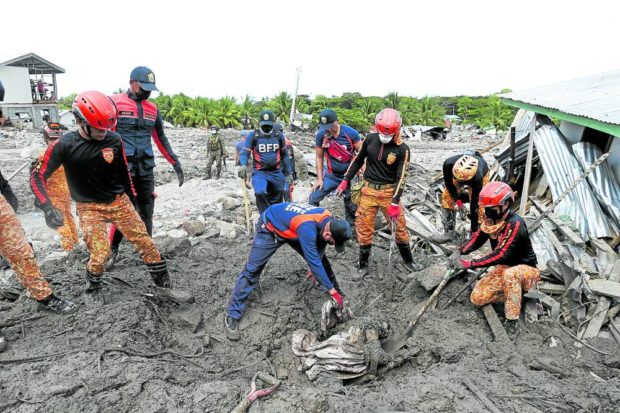
RETRIEVAL Rescuers, in this Oct. 30 photo, conduct a retrieval operation in Barangay Kusiong, Datu Odin Sinsuat, Maguindanao del Norte, to find Teduray tribe members buried in a landslide on Oct. 28 that occurred after days of rain spawned by Several Tropical Storm “Paeng” (international name: Nalgae). —JEOFFREY MAITEM
DAVAO CITY—The Teduray tribal community in Maguindanao del Norte province blamed the National Commission on Indigenous Peoples (NCIP) for failing to act on their 2020 petition against their relocation at the foot of Mt. Minandar in Sitio Tinabon, Barangay Kusiong, of Datu Odin Sinsuat town, that was hit by a landslide and caused the death of 24 tribal folk and the injury of more than 30 others.
The Teduray tribe, which still has to find four missing members as of Sunday, believed that if they were not forced to relocate to a flood-prone area, they would have been spared from the mud and rock slide that wiped out their community on Oct. 28 following days of heavy rains spawned by Severe Tropical Storm “Paeng” (international name: Nalgae).
Ignored plea
A source in the tribe, who asked not to be named because of threats to his life, said at least 127 of the 300 families affected by the forced relocation in December 2020 signed the petition addressed to the NCIP opposing their move to the foot of Mt. Minandar. However, the agency caring for the indigenous peoples’ concerns did not respond to their request to intervene.
The source said they had hoped for the NCIP to investigate or at least send a fact-finding team, but no one came, even if their plea was “urgent,” as they were given only 15 days to leave their coastal homes that a “powerful person” allegedly wanted to turn into a resort.
“Two years and they did not respond, so people died; they were buried by the landslide. So who will answer for that now?” asked the source in Filipino.
The petition was addressed to then President Rodrigo Duterte, the Ministry of Indigenous People’s Affairs (Mipa) of the Bangsamoro Autonomous Region in Muslim Mindanao (BARMM) and the NCIP.
The source, however, said they decided not to send a copy to Mipa after they learned the office had allegedly denied that there was a forced relocation. It was not clear if the petition reached the Office of the President.
The source said the current administration, the BARMM and the NCIP should investigate why their plea in 2020 was ignored.
Fear of backlash
Timuay Alim Bandara, a Teduray leader, confirmed in a separate interview that the community was forced out of their coastal homes no matter how the tribe protested, particularly since it was at the height of the coronavirus pandemic.
He corrected reports that the tribe relocated to Sitio Tinabon because of fear of the tsunami that hit the Moro Gulf in 1976. The community, he stressed, “did not ask to be relocated; they were forced to relocate because a powerful person wanted to use the place for a resort.”
Aside from their anxiety over the safety of the next site where they would be relocated, the survivors of the recent landslide were also worried about the backlash from powerful people who relocated them to the site in December 2020, Bandara said.
Froilyn Mendoza, a member of the Bangsamoro Transition Authority parliament, affirmed in an earlier phone interview that they knew the relocation site was prone to flash floods, but the Tedurays could no longer refuse the transfer “for fear for their lives.” INQ
READ: Maguindanao halts search for missing landslide victims

